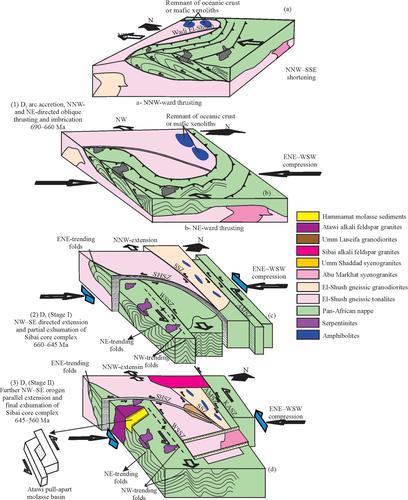当前位置:
X-MOL 学术
›
Acta Geol. Sinica Engl. Ed.
›
论文详情
Our official English website, www.x-mol.net, welcomes your
feedback! (Note: you will need to create a separate account there.)
Neoproterozoic Tectonic Events of Egypt
Acta Geologica Sinica-English Edition ( IF 3.5 ) Pub Date : 2020-02-06 , DOI: 10.1111/1755-6724.14410 Mohamed ABD EL‐WAHED 1 , Zakaria HAMIMI 2
Acta Geologica Sinica-English Edition ( IF 3.5 ) Pub Date : 2020-02-06 , DOI: 10.1111/1755-6724.14410 Mohamed ABD EL‐WAHED 1 , Zakaria HAMIMI 2
Affiliation

|
The Egyptian Nubian Shield (ENS) represents the northwestern part of the Arabian-Nubian Shield and the northern extension of the East African Orogen. The ENS is regarded as being formed due to northward-directed escape tectonics. It is characterized by mild accretion and suture zones dominated by major strike-slip zones with a commonly sinistral sense of movement; some shear zones display a dextral sense of shear. It is dominated by gneisses and migmatites in the south, arc volcaniclastic metasediments and highly dismembered ophiolites in the central parts, whereas its northern part is dominated by late- to post-tectonic granitoids. In southern Sinai, the Neoproterozoic rocks are grouped into four complexes, namely Feiran–Solaf, Sa'al–Zaghra, Kid and Taba. The ENS ophiolites were formed between 730–750 Ma, mainly in a supra-subduction zone setting. The ENS has undergone a Neoproterozoic deformation history involving three successive phases: (1) Early N–S shortening phase (D1), (2) Syn-accretionary phase (D2) and (3) Post-accretionary phase (D3). The initial island-arc stage (780–730 Ma) is a N–S shortening phase initiated by collision between the Eastern Desert tectonic terrane to the north with both the Gebeit and Gabgaba terranes to the south (830–720 Ma). During the arc-splitting and back-arc spreading stage (730–620), voluminous syn-tectonic granitoids intruded into the ENS (750–610 Ma). The E–W-directed compressional/transpressional phase (620–450 Ma) led to the overall uplift of the central part of the ENS and consequently the development and exhumation of the core complexes in oblique convergent zones. The E–W intense shortening deformation resulted also in the formation of NW- and NE-striking sinistral and dextral strike-slip shear zones, respectively. The latest periods of the E–W-directed compressional/transpressional regime were characterized by deposition of the molasse-type Hammamat Sediments unconformably over the Dokhan Volcanics, or interbedded with them. The combined thrusting, folding and sinistral-reverse shearing structures have been interpreted to resulted from the E–W-directed compressional/transpressional phase in response to the oblique shortening of the Arabian-Nubian Shield between East and West Gondwana.
中文翻译:

埃及新元古代构造事件
埃及努比亚地盾 (ENS) 代表阿拉伯-努比亚地盾的西北部和东非造山带的北部延伸。ENS 被认为是由于向北的逃逸构造而形成的。它的特点是轻度增生和缝合带,主要走滑带具有普遍的左旋运动感;一些剪切区显示出右向剪切感。南部以片麻岩和混合岩为主,中部以弧形火山碎屑变沉积岩和高度肢解的蛇绿岩为主,北部以晚构造花岗岩为主。在西奈南部,新元古代岩石被分为四个杂岩群,即 Feiran-Solaf、Sa'al-Zaghra、Kid 和 Taba。ENS蛇绿岩形成于730-750 Ma之间,主要在超俯冲带环境中。ENS 经历了新元古代变形史,包括三个连续阶段:(1)早期 N-S 缩短阶段(D1 ), (2) 同增生期 (D 2 ) 和 (3) 增生后期 (D 3)。初始岛弧阶段(780-730 Ma)是由北部的东部沙漠构造地体与南部的 Gebeit 和 Gabgaba 地体(830-720 Ma)之间的碰撞引发的 N-S 缩短阶段。在弧分裂和弧后扩张阶段(730-620),大量的同构造花岗岩侵入ENS(750-610 Ma)。E-W 方向的挤压/挤压阶段 (620-450 Ma) 导致 ENS 中心部分的整体隆升,从而导致倾斜收敛带中核心复合体的发育和剥露。E-W 强烈的缩短变形还导致分别形成 NW 和 NE 走向的左旋和右旋走滑剪切带。东西向的挤压/挤压状态的最新时期的特征是磨拉石型 Hammamat 沉积物在 Dokhan 火山上不整合地沉积,或与它们互层。联合逆冲、折叠和左旋-反向剪切结构被解释为是由东、西冈瓦纳大陆之间的阿拉伯-努比亚地盾的倾斜缩短引起的 E-W 方向的挤压/挤压相引起的。
更新日期:2020-02-06
中文翻译:

埃及新元古代构造事件
埃及努比亚地盾 (ENS) 代表阿拉伯-努比亚地盾的西北部和东非造山带的北部延伸。ENS 被认为是由于向北的逃逸构造而形成的。它的特点是轻度增生和缝合带,主要走滑带具有普遍的左旋运动感;一些剪切区显示出右向剪切感。南部以片麻岩和混合岩为主,中部以弧形火山碎屑变沉积岩和高度肢解的蛇绿岩为主,北部以晚构造花岗岩为主。在西奈南部,新元古代岩石被分为四个杂岩群,即 Feiran-Solaf、Sa'al-Zaghra、Kid 和 Taba。ENS蛇绿岩形成于730-750 Ma之间,主要在超俯冲带环境中。ENS 经历了新元古代变形史,包括三个连续阶段:(1)早期 N-S 缩短阶段(D1 ), (2) 同增生期 (D 2 ) 和 (3) 增生后期 (D 3)。初始岛弧阶段(780-730 Ma)是由北部的东部沙漠构造地体与南部的 Gebeit 和 Gabgaba 地体(830-720 Ma)之间的碰撞引发的 N-S 缩短阶段。在弧分裂和弧后扩张阶段(730-620),大量的同构造花岗岩侵入ENS(750-610 Ma)。E-W 方向的挤压/挤压阶段 (620-450 Ma) 导致 ENS 中心部分的整体隆升,从而导致倾斜收敛带中核心复合体的发育和剥露。E-W 强烈的缩短变形还导致分别形成 NW 和 NE 走向的左旋和右旋走滑剪切带。东西向的挤压/挤压状态的最新时期的特征是磨拉石型 Hammamat 沉积物在 Dokhan 火山上不整合地沉积,或与它们互层。联合逆冲、折叠和左旋-反向剪切结构被解释为是由东、西冈瓦纳大陆之间的阿拉伯-努比亚地盾的倾斜缩短引起的 E-W 方向的挤压/挤压相引起的。











































 京公网安备 11010802027423号
京公网安备 11010802027423号